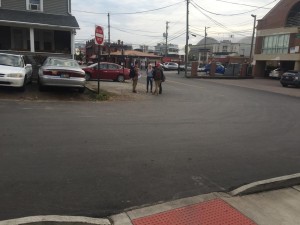Our group, Planned Neighborhood, was scheduled to start our journey at the bus stop on 11th Avenue and High Street at 3:55pm. As most of us walked down High Street, a COTA bus passed us going southbound. Most of the group arrived at the stop around 3:53, and there was no bus to be found. We soon realized that the #2 line was running nearly 4 minutes early and that we had barely missed the 3:55 bus that we intended on taking. The stop was decently kept with benches, a shelter to protect from the elements, trashcans, disabled user seating, and schedules to update riders. The stop felt safe in the afternoon, however, would have minimal lighting for the evening time.
The next bus that arrived showed up at 4:09 pm. This was six minutes later than was posted. At this point our trip has lasted for around 14 minutes and we had just gotten onto the bus. As we entered, the driver greeted us and was very polite. The bus was very crowded with barely any standing room in either the front or the back. There were passengers riding that were from many walks of life, varying in age, race, and perceived socioeconomic status. The sounds of the bus were those of private conversations, which gave an overall muffling sound. A lightboard at the front of the bus gave the date, time of day, and the name of the upcoming stop, which was accompanied by an automated audio recording. This feature made it very simple to recognize where we were along the route. The bus was crowded and loud, but well lit. The smell was moderately stale with the fragrance of sweat, food, or colognes and the seats had fabric coverings. Most riders looked tired as we descended downtown, probably due to long day of work. We rode the #2 line for a few stops, enjoying the city scenes and the company of its residents. The only time the bus remained at a scheduled stop for an unreasonable amount of time was when a disabled elderly woman with a walker took time to board the bus and pay fees, and then was unable to settle in the designated disability spot on the bus due to crowding. We exited the bus on the intersection of Broad and High St.
![IMG_20151116_225351[1]](https://u.osu.edu/crp2110/files/2015/11/IMG_20151116_2253511-1iqxod2-169x300.jpg) The stop was well kept, much nicer than the original stop. There were plenty of covered benches to sit, trashcans, route schedules, and it was very well lit. We all felt very safe and were aware of our surroundings. The connecting #7 line came immediately after we stepped off of the #2 line bus. The #7 was much less crowded than the previous bus. This model of bus was slightly older but was kept very nice over time. The smell was not as stale as the other bus, probably because there were a few windows cracked. The driver was polite as we entered the front doors, asking us how our day had been and making casual conversation. The bus was moderately lit, which could make some passengers feel uneasy, as one side was irregularly dark during transit. Although there were fewer riders on this line, the vehicle was much louder due to the nature of the younger kids riding. We continued on our journey as we approached the outskirts of the German Village. We arrived at our destination within minutes; the Post Office near Whittier and Parsons Ave. Our Arrival time was approximately 4:52, indicating that the first leg of our trip took nearly 40-45 minutes.
The stop was well kept, much nicer than the original stop. There were plenty of covered benches to sit, trashcans, route schedules, and it was very well lit. We all felt very safe and were aware of our surroundings. The connecting #7 line came immediately after we stepped off of the #2 line bus. The #7 was much less crowded than the previous bus. This model of bus was slightly older but was kept very nice over time. The smell was not as stale as the other bus, probably because there were a few windows cracked. The driver was polite as we entered the front doors, asking us how our day had been and making casual conversation. The bus was moderately lit, which could make some passengers feel uneasy, as one side was irregularly dark during transit. Although there were fewer riders on this line, the vehicle was much louder due to the nature of the younger kids riding. We continued on our journey as we approached the outskirts of the German Village. We arrived at our destination within minutes; the Post Office near Whittier and Parsons Ave. Our Arrival time was approximately 4:52, indicating that the first leg of our trip took nearly 40-45 minutes.
It was time to head home. We decided that the easiest route to take home would be to ride the #7 line all the way back to campus. The next bus would come at 5:03. The stop that connected us to the returning line was poor in quality. The stop was marked by a sign. It was a chilly evening and with the wind blowing we stood in the cold, as there was no covered shelter to sit under. Next to the stop, there was a brunch delicatessen with an awning in front of the front door, where members of our group took shelter from the wind, not boding well for the business’ appearance. ![IMG_20151116_225344[1]](https://u.osu.edu/crp2110/files/2015/11/IMG_20151116_2253441-11fjhd2-169x300.jpg)
![IMG_20151116_225333[1]](https://u.osu.edu/crp2110/files/2015/11/IMG_20151116_2253331-1e346ob-169x300.jpg) At night this stop would be a little unsettling, especially for someone who wasn’t familiar with the area. Finally, the #7 line returning to campus arrived. It pulled in 4 minutes late leaving us with a departure time of 5:07. This bus was calm. Only a few additional riders were on the bus back. These riders were reading, listening to music, or just sitting quietly alone. The bus was one of the older models but, again, well kept. It didn’t have an overwhelming smell or sound, just the hum of the bus wheels turning. The driver greeted us politely as we entered, but you could tell that he was getting tired. We continued on our path back to campus. Passing stops here and there. We eventually arrived back at the Ohio Union around 5:35pm. Nearly two hours had elapsed from when we departed, to when we finished. Overall, we were happy to see how easy it was to make it to our destination; we were unimpressed however by how long the routes took. The COTA is a great resource for Columbus residents. One who plans on using the transportation should always be early to ensure that they will make their bus, as schedules can be somewhat unreliable. Likewise, the COTA transit system is not an option for someone on a time crunch; had we been riders who depended on public transportation, we would have arrived significantly late to any event we had scheduled at the intended return time of 5:15pm. There was also a notable problem of crowding on the #2 line at the beginning of our journey, which made it difficult to board/find seating/get off the bus, especially for elderly or disabled riders. Overall, the COTA system is taking strides in city transportation but could use tweaking to make it more equitable and timely.
At night this stop would be a little unsettling, especially for someone who wasn’t familiar with the area. Finally, the #7 line returning to campus arrived. It pulled in 4 minutes late leaving us with a departure time of 5:07. This bus was calm. Only a few additional riders were on the bus back. These riders were reading, listening to music, or just sitting quietly alone. The bus was one of the older models but, again, well kept. It didn’t have an overwhelming smell or sound, just the hum of the bus wheels turning. The driver greeted us politely as we entered, but you could tell that he was getting tired. We continued on our path back to campus. Passing stops here and there. We eventually arrived back at the Ohio Union around 5:35pm. Nearly two hours had elapsed from when we departed, to when we finished. Overall, we were happy to see how easy it was to make it to our destination; we were unimpressed however by how long the routes took. The COTA is a great resource for Columbus residents. One who plans on using the transportation should always be early to ensure that they will make their bus, as schedules can be somewhat unreliable. Likewise, the COTA transit system is not an option for someone on a time crunch; had we been riders who depended on public transportation, we would have arrived significantly late to any event we had scheduled at the intended return time of 5:15pm. There was also a notable problem of crowding on the #2 line at the beginning of our journey, which made it difficult to board/find seating/get off the bus, especially for elderly or disabled riders. Overall, the COTA system is taking strides in city transportation but could use tweaking to make it more equitable and timely.

![IMG_20151116_225434[1]](https://u.osu.edu/crp2110/files/2015/11/IMG_20151116_2254341-22h59g9-300x169.jpg)
![IMG_20151116_225428[1]](https://u.osu.edu/crp2110/files/2015/11/IMG_20151116_2254281-2kgp2jc-169x300.jpg)
![IMG_20151116_225457[1]](https://u.osu.edu/crp2110/files/2015/11/IMG_20151116_2254571-18y66tn-169x300.jpg)



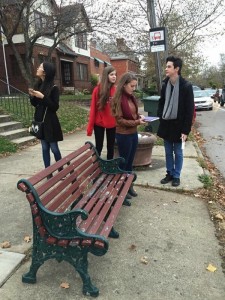



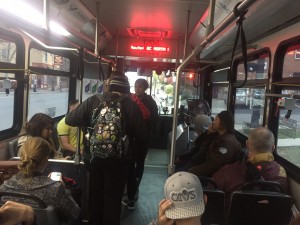



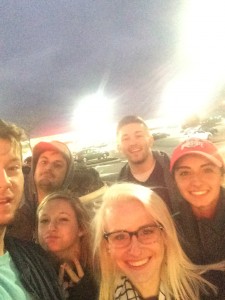

 The Urban Avengers’ trek began at the COTA bus stop on High Street (heading south) near 18th Avenue. While this stop was certainly not chock-full of amenities, it did provide two large, sturdy trash cans.
The Urban Avengers’ trek began at the COTA bus stop on High Street (heading south) near 18th Avenue. While this stop was certainly not chock-full of amenities, it did provide two large, sturdy trash cans.

 So we waited in a *COTA shelter at the southeast corner of Broad and High for the next #10, scheduled for 4:31 (actual arrival 4:33).
So we waited in a *COTA shelter at the southeast corner of Broad and High for the next #10, scheduled for 4:31 (actual arrival 4:33).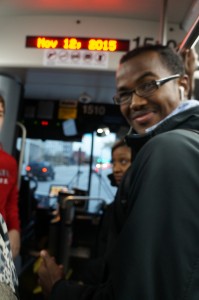 The rest of us were prepared to attempt the entire trip, but when our bus was continually slowed by several red lights and another handicapped passenger situation, we knew we were looking at a 5:00 pm arrival at our destination (at best), and therefore abandoned the Conservatory destination.
The rest of us were prepared to attempt the entire trip, but when our bus was continually slowed by several red lights and another handicapped passenger situation, we knew we were looking at a 5:00 pm arrival at our destination (at best), and therefore abandoned the Conservatory destination.
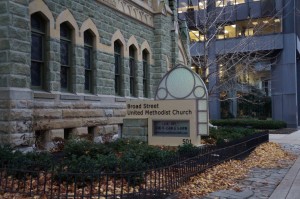 Rhoda Du, Evan Hertzog, Daniel Cirino, Nathan Vale and Gina Scarver
Rhoda Du, Evan Hertzog, Daniel Cirino, Nathan Vale and Gina Scarver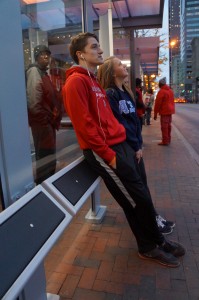 Our feet were literally sticking to the sidewalks in and around the several shelters. There were several shelters, which we did not enter as they were crowded. We did, however, enjoy the slanted horizontal “resting/leaning pads” which are fastened to the front of the shelters, this helped with standing. This stop, overall, was very disappointing and made for an uncomfortable wait, largely due to the smell and dirty conditions.
Our feet were literally sticking to the sidewalks in and around the several shelters. There were several shelters, which we did not enter as they were crowded. We did, however, enjoy the slanted horizontal “resting/leaning pads” which are fastened to the front of the shelters, this helped with standing. This stop, overall, was very disappointing and made for an uncomfortable wait, largely due to the smell and dirty conditions. It is our belief that had we continued to the Conservatory as originally planned, we would not have arrived back at Woodruff & High until possibly well after 6:00 pm; so while we did not want to abandon the destination, we felt it was the correct choice based on timing.
It is our belief that had we continued to the Conservatory as originally planned, we would not have arrived back at Woodruff & High until possibly well after 6:00 pm; so while we did not want to abandon the destination, we felt it was the correct choice based on timing.






 The survey also did not ask about what kind of commercial and residential uses the segment included. The use of the street can influence what should be in place there, and if it serves a purpose. The difference between the two should have an effect on how they are scored. The walkability to things such as parks and/or transit stops should be incorporated into the survey. While the need for a transit stop or park on every segment of street is not necessarily needed, the distance from one to the next should be considered. While the survey asked many questions, for several of the questions, a concise answer could not be given.
The survey also did not ask about what kind of commercial and residential uses the segment included. The use of the street can influence what should be in place there, and if it serves a purpose. The difference between the two should have an effect on how they are scored. The walkability to things such as parks and/or transit stops should be incorporated into the survey. While the need for a transit stop or park on every segment of street is not necessarily needed, the distance from one to the next should be considered. While the survey asked many questions, for several of the questions, a concise answer could not be given. 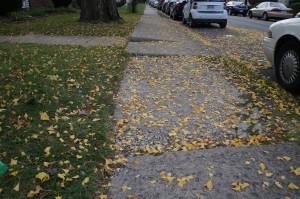 Throughout the segment the streetscape changes and the answers aren’t always clear-cut yes or no answers, but frequently could be both.
Throughout the segment the streetscape changes and the answers aren’t always clear-cut yes or no answers, but frequently could be both.


